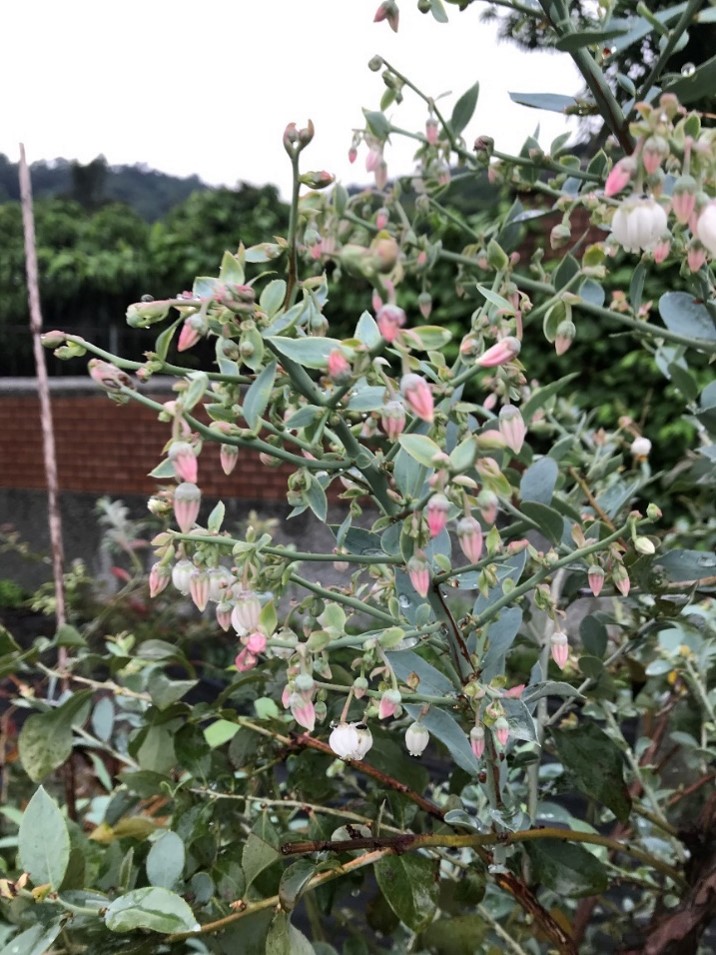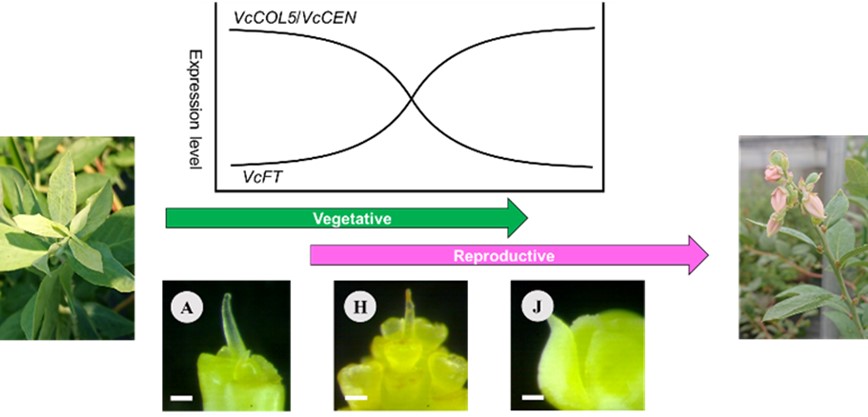藍莓來自北美洲,在原生地溫帶氣候區和蘋果、桃、李等落葉果樹一樣,春天開花、結果,秋天落葉、休眠。然而在臺灣的亞熱帶氣候下,不少品種卻於秋末冬初,植株尚未休眠時,在枝梢頂端二度開花結果。園藝系果樹生理研究室李國譚老師自2016年起,與京都大學果樹園藝學研究室田尾龍太郎及千根久代教授團隊合作,探討藍莓在不同環境下的開花機制。首先由園藝系研究生鄭杰騏,利用栽培於園藝分場的藍莓種原,調查在臺北的自然環境下,具有秋天開花特性的品種及其花芽分化與發育的時機與過程。接著由參與本院與京都大學第一屆碩士雙聯學位學程的日籍研究生大森真史,分析秋天開花與不開花的品種之間,頂芽分生組織發育及開花相關基因表現的異同。經過3年的研究結果發現,某些兔眼藍莓品種,特別容易在秋天於枝梢頂端開花。進一步分析,只在春天開花的藍莓品種,秋末冬初時節,枝梢頂端生長點之活力逐漸停止,最後進入休眠,其間開花相關基因的表現無顯著波動;具有秋天開花特性的品種,入秋後枝梢生長點持續活躍,進而在短日及涼溫環境下,直接分化為花芽並開花,在此過程中,VcFT基因表現大幅上升,VcCOL5及VcCEN基因表現則大幅下降。
研究結果有助於學界了解藍莓開花的環境及分子調控機制,亦有助於在亞熱帶地區篩選適合的藍莓品種,進行產期調節,進而提昇產業潛力。而這些品種不需要經歷冬天的低溫即可開花,在氣候變遷,全球暖化的趨勢下,更具有環境適應靱性及育種價值。
本研究承科技部、台灣花卉生物技術有限公司及自己種有限公司支持,共同參與計畫人員還有園藝系許富鈞老師及生科院陳香君老師。完整內容發表於最新一期的Scientia Horticulturae 期刊。(Horticulture: 4/36 Q1; IF: 4.324)。
Omori, M., Cheng, C.-C., Hsu, F.-C., Chen, S.-J., Yamane, H., Tao, R., Li, K.-T.* 2022. Off-season flowering and expression of flowering-related genes during floral bud differentiation of rabbiteye blueberry in a subtropical climate. Scientia Horticulturae 306, 111458. (published online 26 August 2022)
https://www.sciencedirect.com/science/article/abs/pii/S0304423822005787

兔眼藍莓在臺灣的亞熱帶氣候下,經常於秋天二度開花,表現迥異於溫帶地區。

具有秋天開花特性的藍莓品種,開花相關基因表現與枝梢頂端生長點花芽分化的相關性模式。
NTU and Kyoto University collaboration deciphers blueberry autumn blooming behavior in subtropics
Blueberries are native to north America. Like other temperate fruits, such as apples, peaches, and plums, blueberry bushes bloom and fruit in spring, defoliate and enter dormancy in autumn. However, some blueberry cultivars bloom again in fall before dormancy in the subtropical climate in Taiwan. Beginning at 2016, a 3-year collaboration project between Prof. Kuo-Tan Li from Department of Horticultural and Landscape Architecture and Prof. Ryutaro Tao and Hisayo Yamane from Kyoto University were established aiming to document the mechanism of blueberry autumn bloom. Mr. Chieh-Chi Cheng, a formal graduate student firstly screened the blueberry cultivar collection in Hort Farm to segregate cultivars that often bloom in autumn from those only bloom in spring. The second part of work was then taken over by Mr. Masafumi Omroi, graduate student attending the NTU-KU master’s double degree program, to the analysis apical meristem development and flowering gene expression. The results showed that for cultivars only bloom in spring, the activity of shoot tips in autumn gradually slowed down and eventually became dormant, no noticeable change in flowering gene expression occurred during this period. On the other hand, shoot tips of cultivars bloom in autumn continuously being active and directly transformed into flower buds and bloomed before winter. Meanwhile, expression level of VcFT gene greatly increased while expression of VcCOL5 and VcCEN remained consistent.
This project deciphered the mechanism of environmental and molecular regulations on blueberry flowering, providing useful information for developing off-season blueberry production in Taiwan and for breeding programs aiming to improve the environmental resilience of cultivars for better fit to the climate change scenario.
This work was partially supported by the Ministry of Science and Technology, Taiwan. (Project code: MOST-107-2313-B-002-029-MY3), Taiwan Flower Biotechnology Co., Ltd. Zi Ji Zhong Co., Ltd. and the Fulagai Foundation
Associate Prof. Fu-Chiun Hsu from Department of Horticultural and Landscape Architecture and Dr. Shiang-Jiuun Chen from Department of Life Science, College of Life Science also participated in this project. The result has been published in Scientia Horticulturae (Horticulture: 4/36 Q1; IF: 4.324)。
Omori, M., Cheng, C.-C., Hsu, F.-C., Chen, S.-J., Yamane, H., Tao, R., Li, K.-T.* 2022. Off-season flowering and expression of flowering-related genes during floral bud differentiation of rabbiteye blueberry in a subtropical climate. Scientia Horticulturae 306, 111458. (published online 26 August 2022)
https://www.sciencedirect.com/science/article/pii/S0304423822005787

Some blueberry cultivars frequently bloom again in autumn in the subtropical climate.

A putative model of flowering gene expression and shoot tip growth of blueberry cultivars blooming in autumn.